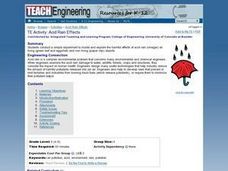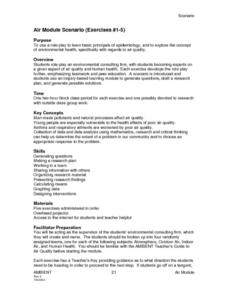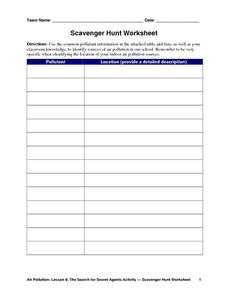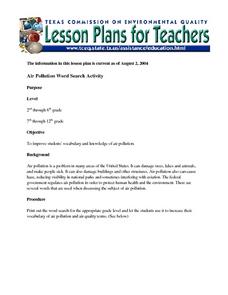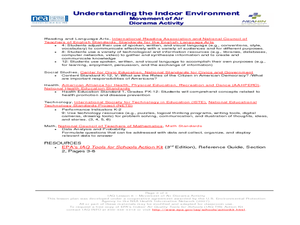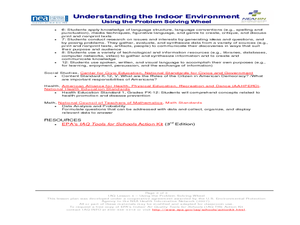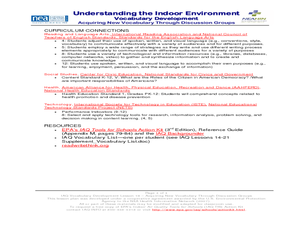Curated OER
Air Quality Issues
Students identify the different layers of the atmosphere. They examine the different types of air pollutants. They also discover laws in effect that work to protect the environment.
Curated OER
Acid Rain Effects
Get out the goggles and conduct a simple experiment to model and explore the harmful effects of acid rain (vinegar) on living (green leaf and eggshell) and non-living (paper clip) objects. Young chemists observe and describe the harmful...
Curated OER
Air Module Scenario (Exercises #1-5)
Students, after researching/analyzing the concept of environmental health to air quality, role-play the basic principals of epidemiology. They act out a specific scenario to generate questions, draft a research plan, and generate...
Curated OER
Scavenger Hunt Worksheet
Exactly how environmentally friendly is your school? From the air fresheners in the bathrooms to the cleaning solvents used in the classrooms, young conservationists search the school grounds for sources of air pollution in...
Curated OER
Pollution and Lung Health
Students investigate how pollution affects lung health. In this pollution and lung health lesson, students build lung models from a soda bottle and balloons, and then discuss how the emissions from fossil fuels can adversely affect lung...
Curated OER
Air Pollution Word Search Activity
Students examine the issues surrounding air pollution. They discover how it affects peoples health and the government's regulations. They complete a word search activity to practice the vocabulary.
Curated OER
Indoor Air: What's the Matter?
Learners investigate the variety and amount of particulate matter in the air. They locate the general sources of pollution for a specific area and develop some suggestions for improving air quality.
Curated OER
Cleaning the Air
Students investigate how engineers design methods of removing particulate matter from industrial sources to minimize negative effects of air pollution. In small groups they design and construct a filter with the goal of removing pepper...
Curated OER
THE BUSINESS OF CLEAN AIR
Students determine that air pollution control is caused by a combination of market incentives and government regulation. They realize that businesses exist to make profits for their owners and that governments make rules for individuals...
Curated OER
Indoor Air Quality
Students examine the role of pollution indoors rather than outdoors. They identify pollutant sources and complete a KWL chart. They also measure pollutant levels and discuss how they can improve air quality.
Curated OER
Movement of Air Diorama Activity
Students make a diorama to illustrate the process of mechanical airflow. In this movement of air lesson plan, students discuss ventilation and air movement indoors. Students discuss ventilation systems and study pictures of the systems....
Curated OER
Cause And Effects Of Pollutants In Ecosystems
Eighth graders define what an ecosystem is, what its make up is and how pollution effects it. For this air pollution lesson students identify the cause and effects of pollution on an ecosystem and trace a food chain.
Green Education Foundation
How Loud is Too Loud?
Ever wonder how loud a sound has to be to cause damage? Young scientists explore sound properties by researching decibel levels. They discuss how sound is perceived by our ears and our brains and why it can cause negative health effects...
Curated OER
Using the Problem Solving Wheel
Students solve problems about air quality. In this air quality activity, students receive a scenario from the problem wheel and find solutions to the air quality problem. Students write a paragraph summarizing what they learned.
Curated OER
Not So Neutral Views
Students explore ways to use indicators to distinguish between acids and bases. They conduct an experiment to model and discuss the harmful effect of acid rain in our living and non-living environment.
Curated OER
Air Quality and Transportation
Second graders study about air pollution and the effects it has on our Earth. Students tally cars on a sheet that has been categorized as follows: One person in car, two persons in car, or three or more persons in car. Students go to...
Curated OER
What's Hiding in the Air?
Fifth graders conduct experiments to study the effects of invisible air pollutants including one with a bean plant. They examine methods of invisible air pollutants.
Curated OER
Acid (and Base) Rainbows
Students are introduced to the differences between acids and bases and how to use indicators, such as pH paper and red cabbage juice, to distinguish between them. They make predictions that can be answered through scientific...
Curated OER
Air, Air Everywhere! Lesson 2: Acid Rain
Middle school environmentalists record the pH of four different liquids, including two aerosol cleaning products. They liken the products to acid rain and speculate in writing which might affect the human respiratory system. Although...
Curated OER
Breathe In, Breathe Out
Students study the respiratory system, the lungs and air. In this respiratory lesson plan students describe technologies that engineers have found that improve the health of the respiratory system.
Curated OER
Invention Project
Students study air pollution and design inventions to prevent indoor environment problems. In this air pollution inventions lesson, students read about and discuss famous inventors and inventions. Students then research indoor air...
Curated OER
Understanding the Indoor Environment: Vocabulary Development
Pupils acquire new vocabulary by reading an assigned text and determining the meanings of unfamiliar words. In this vocabulary development instructional activity, students acquire strategies to use in a small group as they...
Curated OER
Nutrition: It's In Your Hands
Fourth graders use this lesson to focus on their health, nutrition and the state of the environment. In groups, they examine the various types of land, water and air pollutants and compare and contrast a food chain with and without a...
Curated OER
Understanding the Indoor Environment: The Movement of Air
Students discuss HVAC to assess prior knowledge. Students create a rubric to assess their modals of HVAC units, and build the models according to instructions and discussion by the teacher.

